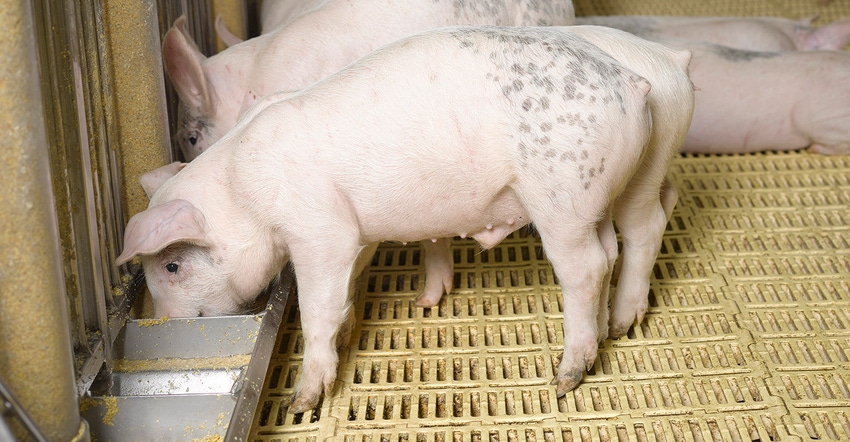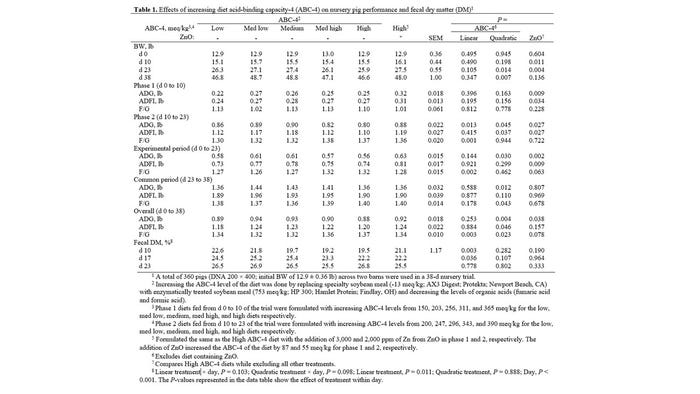Diet ABC-4 influences nursery pig performance, fecal dry matter
Selection of ingredients with a low ABC-4 could assist newly weaned pigs in maintaining an acidic gastric environment.
September 14, 2023

By Ethan B. Stas, Mike D. Tokach, Jason C. Woodworth, Joel M. DeRouchey, Robert D. Goodband and Jordan T. Gebhardt, Kansas State University
Weanling pigs experience a dramatic change from a liquid diet in the form of sow’s milk to a dry cereal-based diet. After weaning, pigs have a limited capacity to produce enough hydrochloric acid in the stomach to maintain an acidic environment.
Certain ingredients in the diet bind more acid than others which can further increase gastric pH. High gastric pH is associated with decreased nutrient utilization and increased undigested protein in the large intestine promoting post-weaning diarrhea. As a result, elevated stomach pH can lead to decreased performance, morbidity and mortality.
The concept of acid-binding capacity-4 involves incorporating low acid-binding ingredients to help maintain an acidic stomach pH for the young pig and improve performance. ABC-4 is measured as the amount of acid in milliequivalents required to lower 1 kilogram of an ingredient or diet to a pH of 4. Selection of ingredients with a low ABC-4 could assist newly weaned pigs in maintaining an acidic gastric environment.
Previous studies have shown a benefit to low ABC-4 diets on nursery pig performance compared to a high ABC-4 diet. However, to our knowledge there are no studies evaluating the optimal ABC-4 level in the diet for a specific weight range or at what point nursery pig performance starts to diminish as ABC-4 changes in the diet. Therefore, the objective of this study was to determine the influence of increasing ABC-4 levels of the diet on nursery pig performance and fecal dry matter.
Procedures
For this study, a total of 360 pigs (200 × 400, DNA, initially 12.9 pounds) were used in a 38-day nursery trial across two barns. Pigs were weaned at approximately 21-d of age and placed in pens of five pigs each based on initial weight. At weaning, pigs were randomly allotted to one of six dietary treatments with 12 replications per treatment.
Pigs were fed experimental diets in two phases with phase 1 from d 0 to 10 post-weaning, followed by phase 2 from d 10 to 23. Phase 1 and 2 diets were formulated to contain 1.36 and 1.35% SID Lysine, respectively and met or exceeded other nutrient requirement estimates established by the NRC (2012). Following the feeding of phase 2 diets, all pigs were placed on a common corn-soybean meal-based diet until d 38 of the trial.
The six dietary treatments consisted of increasing levels of ABC-4. For diet 1, the low ABC-4 diet, was formulated to a value of 150 and 200 meq/kg in phase 1 and 2, respectively. To achieve the low ABC-4 diet, specialty soybean meal (AX3 Digest; Protekta; Newport Beach, California) with an individual ingredient ABC-4 of -13 meq/kg was included at 12.5 and 10.0% of the diet in phase 1 and 2, respectively with fumaric acid and formic acid also included at 0.50 and 0.48% of the diet, respectively for both phase 1 and phase 2 diets. Fumaric acid and formic acid had individual ABC-4 values of -10,873 and -8,287 meq/kg, respectively.
For diets 2 (med low), 3 (medium), 4 (med high) and 5 (high), increasing ABC-4 level of the diets was achieved by progressively replacing specialty soybean meal with enzymatically treated soybean meal (753 meq/kg; HP 300; Hamlet Protein; Findlay, Ohio) on an SID Lysine basis and decreasing the levels of fumaric acid and formic acid proportionally for each diet.
Diets 1 through 5 contained 110 ppm of zinc provided by the trace mineral premix and did not contain any added zinc oxide. Diet 6 was considered a positive control diet and utilized the same formulation as the high ABC-4 diet except with the inclusion of 3,000 and 2,000 ppm of zinc from ZnO in phase 1 and 2, respectively. The addition of ZnO increased the ABC-4 of the diet by 87 and 55 meq/kg for phase 1 and 2, respectively. The ABC-4 of the diet was increased by approximately 50 meq/kg as diets increased from the lowest to the highest ABC-4 levels for each diet in both phase 1 and 2.
Individual pig weights and feed disappearance was measured on d 10, 17, 23, 31 and 38 to determine average daily gain, average daily feed intake and feed to gain. Fecal samples were collected on d 10, 17 and 23 to determine fecal dry matter percentage from the same three medium weight pigs from each pen.
Results
For increasing ABC-4 levels, during phase 1 (d 0 to 10) there were no differences in growth performance (Table 1). In phase 2 (d 10 to 23), there was a quadratic response observed where ADG and ADFI were highest for pigs fed the medium low and medium ABC-4 diets. Pigs fed increasing ABC-4 had poorer F/G.
For the entire experimental period (d 0 to 23), there was a quadratic response observed where BW and ADG was highest for pigs fed the medium low and medium ABC-4 diets. Pigs fed increasing ABC-4 had poorer F/G. In the common period (d 23 to 38), there was a quadratic response observed where ADG and F/G was most improved for pigs previously fed the medium low and medium ABC-4 diets.
Overall (d 0 to 38), there was a quadratic response observed where BW, ADG, ADFI and F/G was most improved for pigs fed the medium low and medium ABC-4 diets. For fecal dry matter, there were no significant treatment × day interactions. On d 10 and 17, fecal dry matter percentage decreased as dietary ABC-4 increased. There was a day effect observed where fecal dry matter progressively increased from d 10 to 23.

Kansas State University
During phase 1 (d 0 to 10), phase 2 (d 10 to 23), and the experimental period (d 0 to 23), pigs fed diets with ZnO had increased BW, ADG and ADFI compared to pigs fed diets without ZnO. In the common period (d 23 to 38), there were no differences between pigs previously fed diets with or without ZnO.
Overall (d 0 to 38), pigs fed diets with ZnO had increased ADG compared to pigs fed diets without ZnO. In the experimental period (d 0 to 23) and overall (d 0 to 38), pigs fed diets with ZnO tended to have improved F/G compared to pigs fed diets without ZnO. For fecal dry matter, there were no differences between pigs fed diets with or without ZnO for the duration of the experimental period (d 0 to 23).
In conclusion, pharmacological levels of Zn from ZnO improved nursery pig performance as expected. The medium low and medium ABC-4 diets improved performance compared to the low, medium high and high ABC-4 diets. Decreased performance in the low ABC-4 level may be due to decreased palatability from the level of acidifiers as ADFI was lowest for this diet.
This study also suggests formulating diets to an ABC-4 level of 203 to 256 meq/kg in phase 1 and 247 to 296 meq/kg in phase 2 can result in numerically similar performance to pigs fed high ABC-4 diets containing pharmacological levels of Zn from ZnO.
This and other data related to ABC-4 formulation in nursery pig diets will be discussed more in-depth at the 2023 K-State Swine Industry Day on Nov. 16.
You May Also Like



